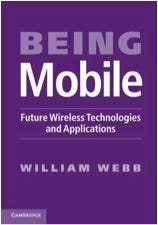Being Mobile
October 13, 2010

By William Webb

BeingMobile
In his new book, Being Mobile, Professor William Webb, director of technology resources at UK regulator Ofcom, takes a look at what mobile technologies and applications will bring us in the future. Ahead of the serialisation of Being Mobile on Telecoms.com, Webb provides an overview of the book’s themes.All too often predictions of new uses for mobile communications technology have proven inaccurate. Many new services promoted by mobile operators have struggled or failed, including WAP, group calling, picture messaging, mobile TV, location-based services and more (although some of these found success many years after the predictions were made).
New technologies such as 3G appeared for many years to be unnecessary because there was little need for the speed and capacity it enabled. And then in the space of a year or two the networks were suddenly saturated and congested. A boom in video-calling has been predicted for at least 50 years—the Facetime application on the iPhone 4 is just the latest in a long string of attempts to make it happen. Conversely, the success of text messaging and, more recently, the application stores were not foreseen.
What many of the failed predictions have in common is the assumption that a service will be successful simply because it is technically possible. Understanding what ‘being mobile’ will be about requires much more than charting the rise in technology, although as an underlying enabler, an understanding of the technology is essential. Beyond that, though, we need to understand the requirements of users, the eco-systems and value chains and hence the behaviour of the key actors, the reaction of complex systems such as healthcare to new concepts, and much more.
It is often thought that technology moves quickly, particularly in the areas of computing and communications. This is true in part—improvements in the technologies that affect the handset, such as storage capability, screen resolution and processing power, are indeed coming quickly. Storage, for example tends to grow by an order of magnitude every six to seven years. This is why new handsets seem so much better than last year’s model (iPhone antenna issues excepted).
But it is far less true for the networks that actually carry the traffic. Here, we are coming close to the physical limits on the amount of information that can be transmitted, and economic limits on the density of base stations that is viable.
One key trend to watch is the move towards increasingly hierarchical networks, where most communications are carried out over femtocells with communications moving to larger cells away from the home and urban areas. This trend is a response to the limits reached for larger cells and to the recognition that users are deploying wifi within their homes. Devices will become increasingly able to find small cells and use them to download large files, synchronise content and enable applications like video calls.
But because such cells are not always available, this will drive applications to behaviours such as downloading video files whenever it is easy to do so in anticipation of them being needed later. And some applications—such as Apple’s video-calling system—will only be available when connected to small cells.
Another development that has generated much interest recently is the emergence of “white space devices” (WSDs). These devices look for radio spectrum that is licensed to other users—but currently not being used by them—and transmit on this spectrum as needed. Such devices could provide increased capabilities for short to medium range communications and for unlicensed devices—the sort of scenarios for which Bluetooth and wifi are currently used.
The other force acting on technology and wireless usage is the green agenda. Wireless systems all consume power—and the more systems there are, the more power tends to get consumed. Technologists are working hard to reduce the energy requirements for each system but there may be a consumer backlash against a proliferation of wireless devices, for example multiple different home nodes that all need to be powered.
When it comes to the applications enabled by these technologies, many incorrect assumptions have been made. Operators assumed that applications needed to offer time or efficiency gains to users by empowering them to carry out tasks while mobile that were previously done at a desk. In practice, and by contrast, users have embraced applications that actually waste time, albeit in an enjoyable way.
Perhaps a better way to look forwards is to consider the mobile to be a gateway to applications. Indeed, taken to its logical conclusion the mobile could be used to access a social network like Facebook, which would then provide the onward communications channel—a voice call to a friend, for example. The mobile and the mobile networks are simply data pipes that enable the basic connectivity. Such an outcome would have significant impact on the mobile operators, which would face a weakening of one of their core assets; the relationship they now have with subscribers.

William Webb
Professor William Webb
Use of location information is an area that seems likely to expand. There is still much that can be added to basic “where am I” and “how do I get there” applications, including the provision of congestion information, or the recommended use of multiple modes of transport. Providing location information to others is also in its infancy. A “whereabouts clock” that sits on the kitchen wall and shows the location of family members is still not available, despite being technically simple to achieve. Applications that overlay virtual information on the real world are also emerging. From tourist information on what can be seen in the vicinity through to details of homes for sale in the region, the possibilities are vast.
Machine-to-machine applications have been discussed for many years and, with the rise of applications such as smart metering, are now enjoying a good deal of coverage.
And yet the familiar disjuncture between technical feasibility and market demand shows itself once more. Some proponents of M2M solutions argue that it must be useful to track every object and know what it is. It is plausible that there is some value in doing this, but there is also cost associated with developing the sensors and tracking devices. It seems unlikely that “everything” will be tracked just because it is possible, and more likely that specific niche areas will emerge where tracking is worthwhile—such as baggage passing through an airport.
Mobile applications could add real value in healthcare, meanwhile with increased pressure to keep patients at home for longer, wireless technologies can be used to monitor vital signs, ensure medication is taken, track patients and alert healthcare professionals as needed. This is an interesting example where, despite the “business case” being clear and compelling and the technology mature, deployment remains limited.
Healthcare professionals tend to resist change, new healthcare systems require rigorous testing and those in the home often do not want to be continually monitored. Funding is often needed and the body required to provide the funding may not be the one benefitting from the reduced patient costs. Unexpected side effects, such as increased hypochondria might also be an outcome. Despite these difficulties, this is an area where increasing pressure on resources will make the gradual introduction of specific solutions to particular illnesses and disabilities very likely.
Transport is less compelling. While wireless solutions that reduce congestion, cause cars to brake if the car in front slows, and so on, can be envisaged, their introduction is unlikely. This is because most systems require agreement across many countries, car manufacturers, Governments, mobile operators and others—and achieving this often proves too difficult. Also, systems built into cars need a lifetime of ten years or more, something which is hard to guarantee with current wireless systems. Simpler solutions, such as using Bluetooth within the car to link to a user’s mobile and forward-looking radar to brake the car sharply when needed are more likely.
A number of applications expected to prove popular will be based in or around the home. Over half of all mobile calls originate within buildings, much entertainment is consumed in the home, some parts of healthcare are centred on the home as discussed above and new concepts such as smart grids could use home networks to control electricity demand. Many homes now have broadband connectivity and wireless distribution using wifi, and this forms a suitable platform for most applications. An increasing number of home applications seem likely although the “smart home” is still some way off—the costs and inconveniences of enabling wireless connectivity to the heating, doors, major appliances and so on still outweigh the benefits.
Consumers will make wide ranging use of their mobile for entertainment purposes—for filling in time while out and about and for interesting distractions during the day. It will also be the mechanism to link to many different forms of connectedness, based in part around social networking but using a variety of different channels to fit the need and the moment. For some it may also provide healthcare-related functions such as monitoring and the underlying wireless networks may form part of smart grids and gradually growing intelligence in the home. But being mobile is not about a host of “valuable” communications. It is unlikely that wireless will significantly change transport, life at home, or indeed life more generally.
Being Mobile in the future is more about a lifestyle than it is about solving problems with everyday life. It is a little like clothing—you need clothing to stay warm and decent but most people buy most of their clothing for its appearance and its feel rather than its practicality and many buy on a whim rather than a clear strategy. The mobile has many similarities to clothes—it is always carried, makes a fashion statement, is needed for basic functions but bought for the advanced things that it can do.
Above all, Being Mobile is about fun. It’s about using the mobile to entertain while travelling or in a moment of downtime. It’s about social connectedness, with the mobile as a device that can facilitate many different forms of communications with many different communities. It’s about relying totally on the mobile to get you through the day.
You May Also Like










_1.jpg?width=300&auto=webp&quality=80&disable=upscale)
